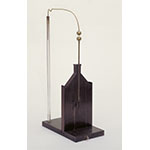This model of the façade of a house gives a spectacular demonstration of the destructive effect of a lightning bolt striking a house with an imperfect lightning conductor.
In the experiment, a small piece of mahogany jumps out of the façade when the conductor is interrupted. If, instead, the piece is arranged so as not to break the conductor circuit, the electricity will be discharged to the ground, leaving the house intact. The brass wire electrode, insulated by a glass tube, serves as a model for an "electric thunder cloud." It forms an explosive spark-gap with the ball of the conductor, set into the façade and rising above the chimney. The ball can be removed, revealing a sharp point.
Filippo Lucci depicted a very similar device in the Stanzino of the Matematiche of the Uffizi in 1780—clear evidence of the popularity of such demonstrations in the late eighteenth century. Provenance: Lorraine collections.









